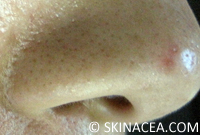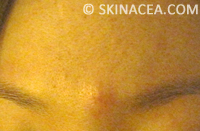What is Acne?
An explanation of the different types of acne |
If you have stumbled upon this site, then you probably have a good idea of what acne is. I won't go into too much detail, but acne is basically formed when a pore in your skin becomes blocked with dead skin cells or oil, creating a nice little home for p.acnes (the acne bacteria).
Acne comes in many forms and pops up unannounced, usually at the most inconvenient times, such as on picture day or the night before a big date. However, understanding what type of acne you have will help you select the most effective treatment to get clear skin fast. Keep reading for pictures, explanations, and treatment suggestions for the different types of acne.
Note: What causes acne for one person may not cause acne for another, so an acne treatment that clears up skin for one person may or may not clear up skin for another.
Different Types of Acne
There are more technical terms for the types of acne, defined in detail here, but I tend to think of acne in these five categories:
- Clogged pores: These are tiny, skin colored bumps that make your skin texture look rough. Sometimes you only notice clogged pores when light hits you at a bad angle or when you feel little bumps while washing your face. Clogged pores are non-inflammatory and painless, but nonetheless a pain in the neck. I tend to get this kind of acne on my forehead and chin, however they can show up anywhere on your face. They are easy to extract with a comedone extractor, but persistent in terms of prevention. Clogged pores will sometimes stick around even if you are using prescription strength retinoids! However, in my experience, exfoliating is the best way to treat and prevent clogged pores. Making sure your skin is moisturized is also important because I notice I get more clogged pores whenever my skin is dry.

Picture of my clogged pores
- Blackheads: These are most commonly found on the nose and in the T-zone (which is the forehead, nose, and chin area). Just like the name sounds, blackheads look like tiny black dots on your skin that appear due to oxidation. Like clogged pores, they are also quite stubborn and seem to come back within days of extraction. Even though I am diligent in using a BHA treatment every night, the blackheads on my nose remain as unyielding as ever. The good news is, they really aren't that bad in the grand scheme of pimples. I'd take a handful of blackheads over a cystic pimple any day.
NOTE: Blackheads are often mistaken for sebaceous glands or sebaceous filaments. They can look the same, but sebaceous glands, much like pore size, are determined genetically and when you "extract" them, usually yellow colored plugs or white squiggly stuff comes out. When you "extract" blackheads, the sebum is darker in color.
Picture of my blackheads
(sorry for the close-up of my nostril) - Whiteheads: To me, whiteheads are pimples that have a white head, whether they are the small, harmless ones or the red, inflamed ones, better known as pustules and papules. It's just easier to lump them into one category. Whiteheads are the kinds of pimples that most people refer to anyway when they say they have a pimple or zit. They are also the type of acne that the majority of acne sufferers strive to treat and prevent. Whiteheads first start out as a small red bump and usually come to a head in 3-4 days. They can pop up all over your face and even on your butt and back. They are super frustrating because it's hard to know what causes them, making them difficult to treat. It takes a lot of time and patience to test out various acne treatments until you find the one that works for you. However, whiteheads do respond well to treatments after you find your holy grail product. I know that's not really saying much, but my face used to look like this and I haven't had a breakout like that in years since I've learned how to clear my skin. *knock on wood*

A nice whitehead on my cheek
- Cysts: Alas, the dreaded cyst! These monstrosities are those ginormous, sore, tumor-wanna-be pimples that everyone hates.
They're not only big, they also hurt! You will know when you have one of these puppies because they are just absolutely horrid. Cysts start deep within your skin layer and usually indicate an internal issue, whether it's hormones, allergies, or food sensitivities. They take a long time to heal and rarely respond to surface treatments. The only guaranteed way to get rid of a cyst is to let it run its course. One thing’s for sure, never, ever attempt to pop a cyst! You will only cause a deeper inflammation that will take even longer to heal. And if you rupture your skin in the popping process, you run the risk of getting a scar or long-lasting red mark.

A big ol' cyst in between my brows (ouch)
- Dormant pimples: Dormant pimples, hibernating pimples, or inactive pimples are not really a class of acne on their own. Rather, they are what I like to call the pimples that used to be inflamed, but for some reason recede back into your skin and remain a painless bump. They no longer hurt when you touch them, but they still linger around in your skin. Sometimes you don't see them as much as you feel them. They often look like large clogged pores and can linger around in your skin for a quite some time, long after the initial inflammation and redness of the pimple has gone. They can be really stubborn, but they usually respond to gentle exfoliation.
Note: For information about body acne, please check here.
Now that you have been introduced (or re-introduced) to acne, please understand that acne is not your fault. You don't get acne because you're dirty or because you don't wash your face enough. In fact, almost everyone I know who has dealt with acne, knows more about skin and how to take care of it than their clearer-skin counterparts.
The fact is anyone can get acne. Teenagers, young adults, people in their fifties...you name it! Acne is so difficult to treat because it's incredibly hard to figure out the exact cause of the acne lesions for each individual person. To treat acne, you also have to be very patient and go through a long trial-and-error experiment until you find what works for you. So, not only do you have no idea why you keep getting pimples, you also don't know what product will actually work on your skin until you try everything out for yourself. It really sucks.
However, just because acne is difficult to treat doesn't make it impossible to treat. Read up on as much information you can about the subject. Figure out a good skin care routine for yourself, learn how to choose products wisely, and be aware of all treatment options. Consulting this chart and acne face map will also give you an idea of possible acne culprits and aggravators.
It is a lot of hard work, but I believe that hard work always pays off! Take me for instance. At one point in my life, I had all types of acne on my face for a stretch of 2-3 years. But now my skin is much better, so definitely never lose hope.
Last updated: May 6, 2013
Related articles:
- 4 Golden Rules for Beautiful Skin
- FAQ: Does popping pimples make them go away faster?
- My Glycolic Acid Peel Experience
- How to Get Rid of Keratosis Pilaris
- Use Retinoids the Right Way
